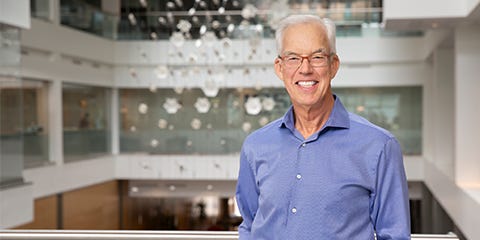- Mission BioCapital raised $275 million and plans to help overlooed founders start biotechs.
- Its leadership also runs shared lab facilities in hubs like Boston, San Francisco, and Durham.
- It works with 380 drug startups each year, providing lab space, equipment, and sometimes funding.
The biotech leaders Peter Parker, Johannes Fruehauf, and Doug Crawford are doing double duty in the startup ecosystem.
The trio is part of the leadership at Mission BioCapital, a life-science investment firm with offices in the Boston area and San Francisco. Since Parker cofounded Mission BioCapital in 2010, the leadership team has also launched more than a dozen WeWork-type spaces for biotech and life-science startups near its headquarters and in other cities like Philadelphia, Dallas, and Durham, North Carolina.
There, entrepreneurs can rent small offices and lab benches, sharing the expensive tools that drug companies use to run early experiments so they can show investors their products just might work.
Now, the team wants to extend the influence it’s had in biotech real estate to biotech launches. Mission BioCapital just raised its largest-ever investment fund, $275 million, half of which will go toward funding outside companies, with the other half going to a new strategy of cocreating companies with entrepreneurs.
The venture-capital firm will invest in some of the 380 startups that rent space each year in the team’s lab facilities, called LabCentral, BioLabs, and MBC BioLabs.
Parker and Fruehauf launched LabCentral in the Boston area in 2013. Since then, it’s served as the early launchpad for companies like Rubius Therapeutics, a company that genetically engineers red blood cells, and Kronos Bio, which develops cancer therapies. The Nobel Prize winner Jennifer Doudna’s latest startup, Mammoth Biosciences, started out at MBC BioLabs, which is run by Crawford.
These lab spaces have become a bedrock of the drug-startup community, just as Y Combinator has become an institutional part of the tech scene.
They have also given Parker, Fruehauf, and Crawford a unique vantage point into how startups are being built and launched. And they’ve been noticing gaps, including a lack of seed financing and poor support for independent entrepreneurs. Last year, Mission BioCapital brought on the biotech veteran Michael Taylor to work with entrepreneurs and cocreate startups.
LabCentral
VC firms building startups internally are ‘missing a great deal of innovation’
When Mission BioCapital was founded more than a decade ago, many biotech investors relied on pitches from young companies to find investment opportunities. But since then, more biotech investment firms have focused on building teams of in-house entrepreneurs to create new startup ideas. That way, they can install their own leadership teams and grab a higher stake in the company.
But while companies like Flagship Pioneering are known for exclusively funding their internal ideas, Mission BioCapital seeks outside entrepreneurs.
There are many, many good ideas floating around outside these venture firms that just need some fostering, Parker said. Between 300 or 400 of the 500 applications submitted to LabCentral or BioLabs each year are worth investing in, he said.
“You’re missing a great deal of innovation if you’re relying on your in-house smarts,” Fruehauf said.
Mission BioCapital
Mission BioCapital wants to fill the biotech seed-funding gap
One of Mission BioCapital’s first investments out of its new fund is in a cancer startup called ARase Therapeutics. While he had previously served as a scientific cofounder of another biotech, ARase CEO Paul Chang needed some help with all the tasks relegated to an early-stage CEO: incorporating a company, fundraising, and hiring a research team and middle management.
Mission BioCapital gave ARase $6 million in seed funding last year and became a cofounder of the company. It plans to give between $5 million and $8 million to companies when it joins as a cofounder.
That seed funding is an important first step for founders working outside large venture-capital firms that create companies in-house. Record amounts of venture capital are flowing into drug development right now — 28.5 billion last year and more than $20 billion in the first half of 2021, according to PitchBook. But those firms are pulling in a large portion of it, Fruehauf said.
Credit: Source link




















